Another year, another revenge mission against Real Madrid in the Champions League. So how do Liverpool win it this time? Harry McMullen takes a tactical look.
The Reds have been second-best to Real in three of the last five European campaigns, including two finals.
Yet there’s also the prospect of another chapter in what, tactically speaking, has been a fascinating on-pitch rivalry.
With the two sides meeting so recently in Europe, a look at the tactical ins and outs of last year’s showpiece could inform the upcoming clash.
What lessons can we learn from that night to finally beat Real?
I’ve written this piece because we earned the right to have this final in our history, and if you want to read about it, you should have that right, too.
Courtois is the key

Thibaut Courtois’ massive performance was decisive in Paris, with the Belgian saving all nine shots on target to secure the clean sheet.
Liverpool had 29 efforts at goal to Madrid’s four, leading to an expected goals (xG) scoreline of Liverpool 2.2 – 0.9 Real Madrid.
For context, Mo Salah alone had an xG of 1.0 at the end of the night – in the data, he outscored the entire Madrid team.
Yet Courtois denied him time after time.
On the flip side, Alisson didn’t make a single save, with 0.7 of Madrid’s xG coming from Vinicius Jr.’s tap-in that settled the contest – Madrid’s only shot on target.
But Courtois also served an important function in the Madrid buildup.
Liverpool looked to press high from Madrid’s goal kicks, disrupting their buildup play and attempting to steal the ball in dangerous areas.
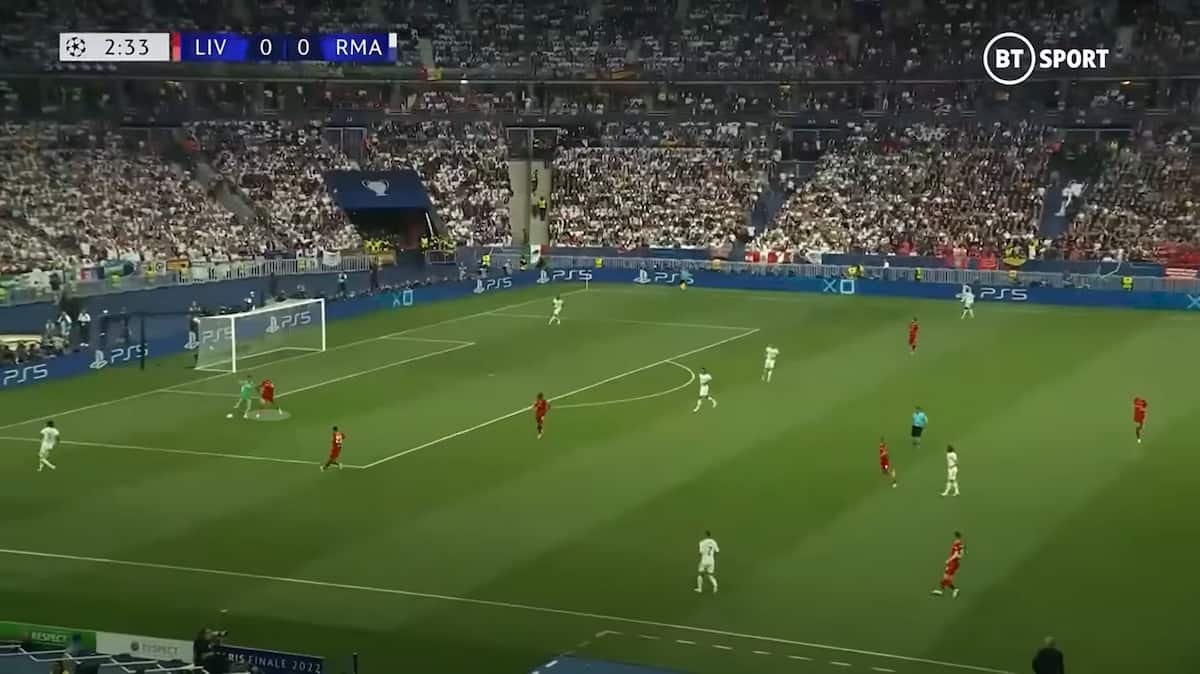
As the game wore on, Courtois began playing more mid-range passes, allowing Real to bypass Liverpool’s first line of pressure.

With the Belgian just back from injury for the trip to Anfield, Liverpool will need to find a way past him for only the second time in four games – and be smart about how they try to steal the ball.
Be hungry to defend
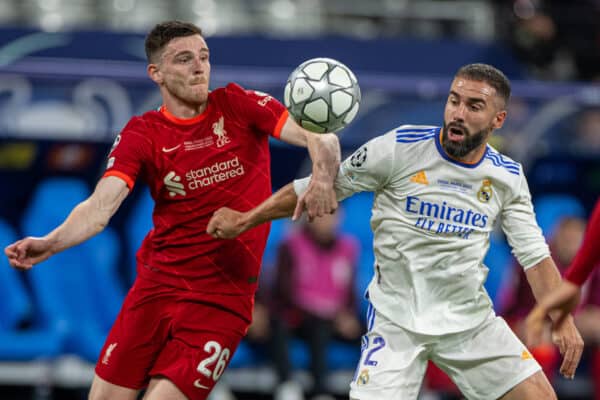
Liverpool came into this game having narrowly missed out on the quadruple, yet the defensive issues which have dogged the current campaign were already evident.
The first warning came shortly before half-time.
Here, Madrid find a gap through the forward press and build on the left flank. Red shirts shuttle across to pressure the ball.

When David Alaba gets possession in space, there are several options for a dangerous switch of play.
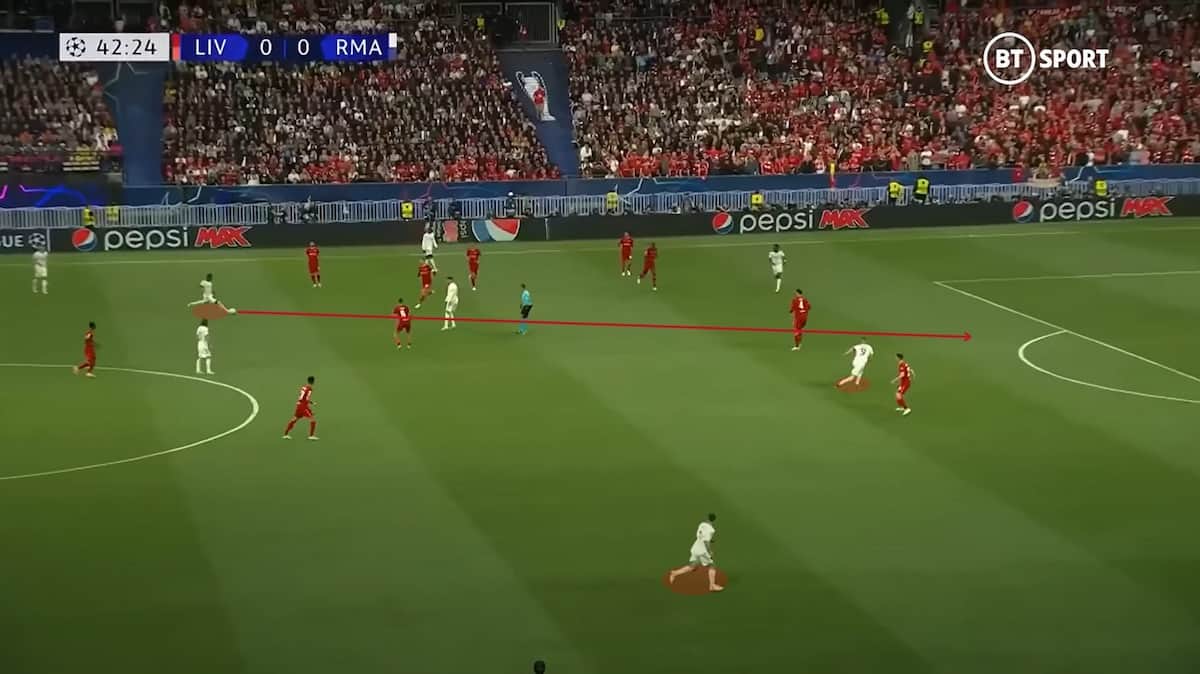
Liverpool’s defensive approach is risky – sometimes the opponent creates a dangerous opening. When they do, the defenders have to earn their money.
What happens here is farcical. Alisson appears to make the block, but then the ball ricochets back into danger and Liverpool’s defence are all over the place.
Karim Benzema tucks the ball into the back of the net…

…but the goal is correctly ruled out by VAR. Still, it’s a clear warning.
Liverpool’s fragility at set-pieces appeared in this game, too. Madrid had the chance to play a free-kick into the box in the 75th minute.
The entire back line watches the ball, waiting to see if they can squeeze up and play offside.
A simple dummy allows Madrid to solve this tactic, with several deep runners beating the high line.
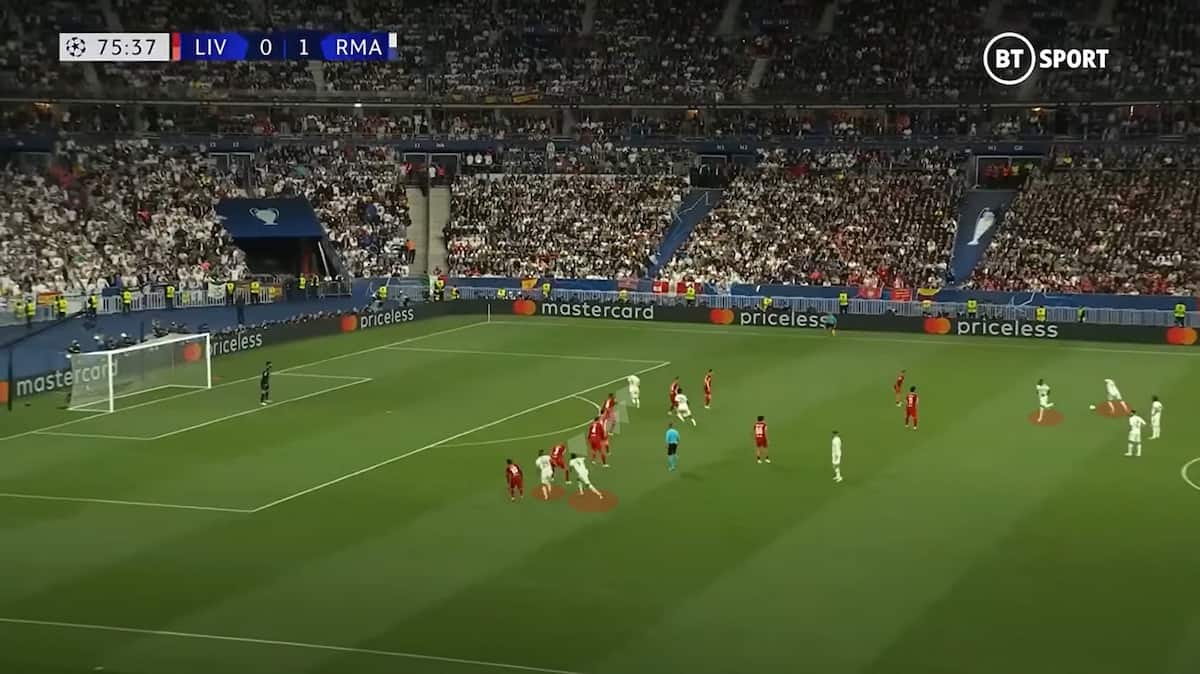
Liverpool are left scrambling back. Casemiro has a clear sight of goal and plenty of support…
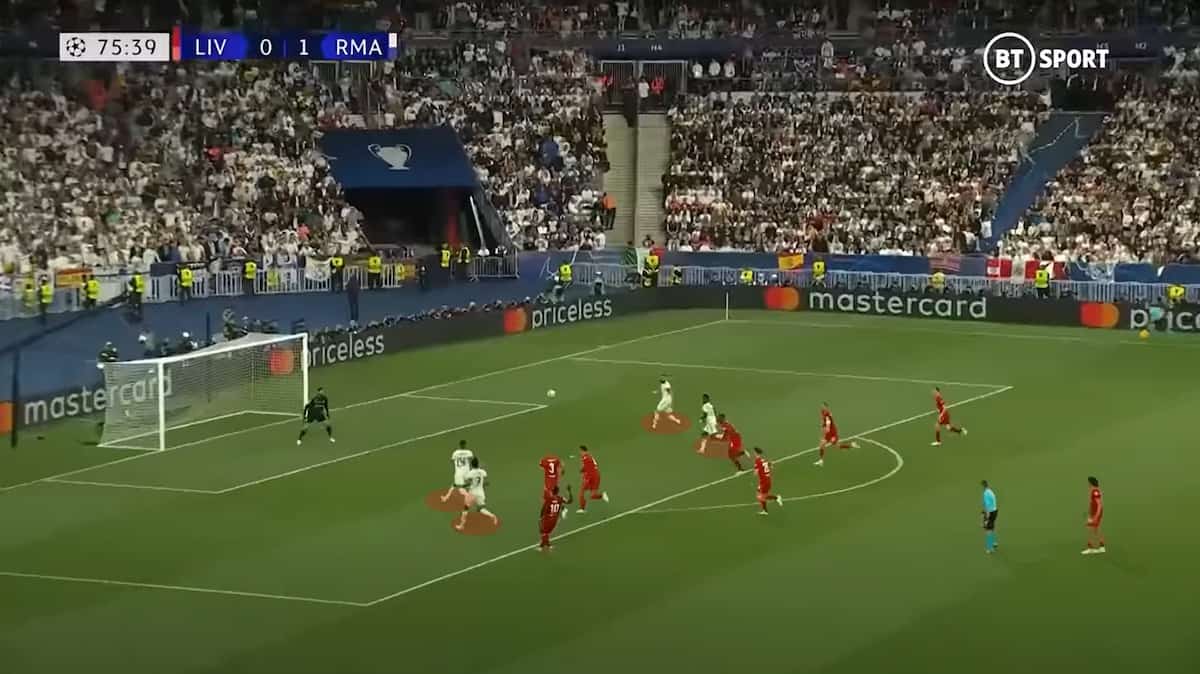
…but he manages to misplace his pass completely. Liverpool are let off the hook, but Madrid are unlikely to be so generous at Anfield.
The decisive goal featured all of Liverpool’s now-familiar defensive lowlights.
First, Real beat the forward press too easily.
While Luis Diaz was an outstanding addition in the second half of the season, with brilliant energy and desire off the ball, the nuances of Liverpool’s forward press – such as pressing triggers, using cover shadows and awareness of where your team-mates are – take time to instil.
Here Diaz decides to cut off the pass back to Courtois, inadvertently opening a pass out to Dani Carvajal.
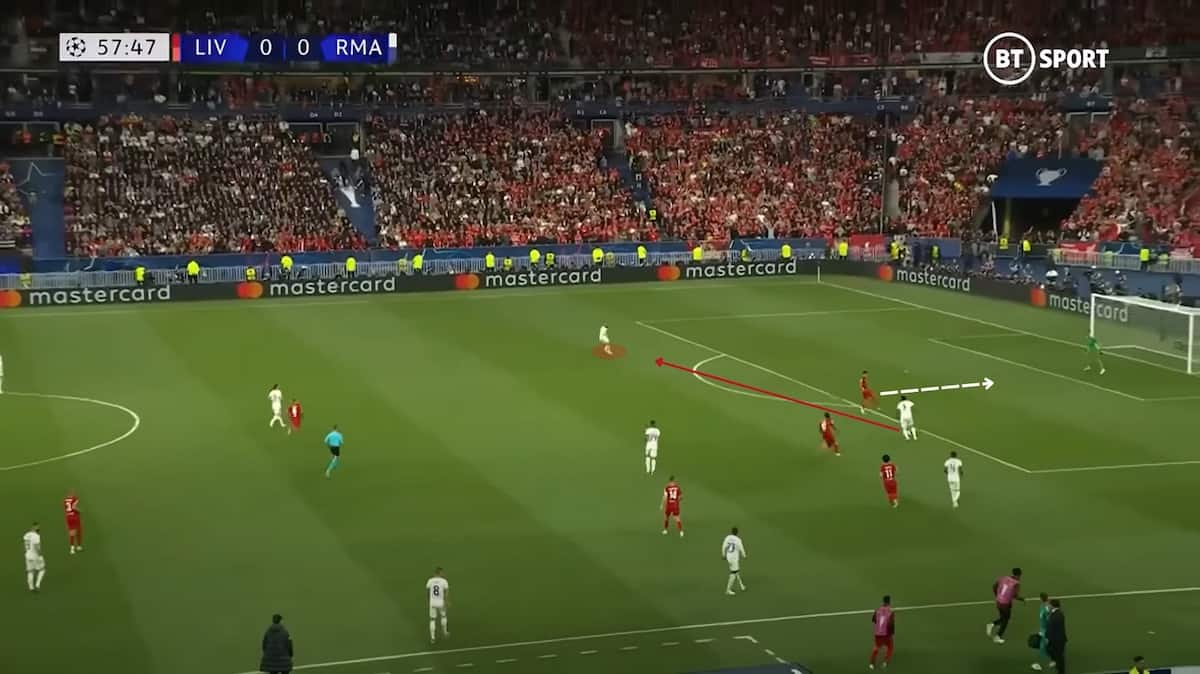
Thiago rushes across to challenge his countryman, but pulls out of the duel.
Luka Modric gets the ball and dribbles his way out of Andy Robertson‘s reach. Liverpool are unsure whether to follow or drop off, opening space for Carvajal to get the ball on the turn.

Suddenly Federico Valverde is able to run at the back line, with the attack and the midfield out of the game.
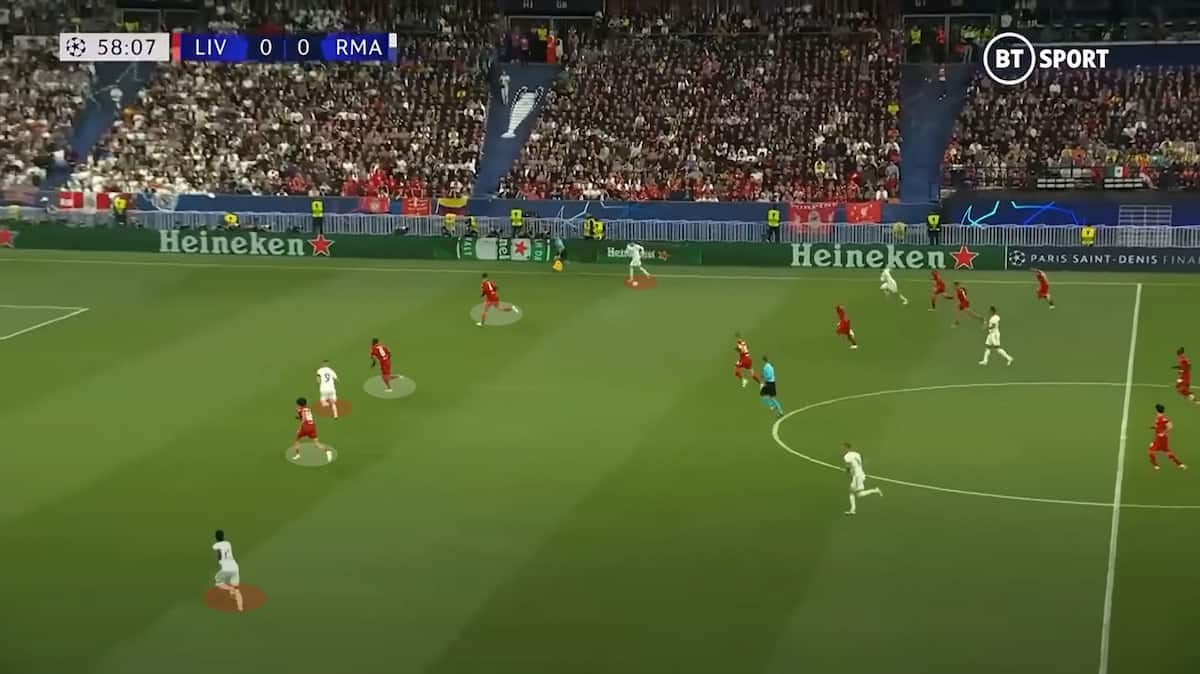
We all know what follows, right? Valverde fires the ball across, Trent Alexander-Arnold is caught ball-watching and Vinicius Jr. arrives unmarked at the back post to score.

Except, take a look back at the images again.
As the space opens up in the midfield, Robertson is still tracking back, with the back line shifting across to cover. Benzema positions himself intelligently between Alexander-Arnold and Ibrahima Konate on the right.
In this situation, teams can either drop off and cover the space or push up and press the ball – but not both.
Liverpool are a pressing team, so they target the ball, but Virgil van Dijk hedges his bets rather than attempting to tackle.
His body shape for the cross signals to the rest of the defence that they should push up to spring the offside trap if he can’t block Valverde’s ball in.
But it all happens so quickly that Vinicius Jr. is well onside when the ball comes across.
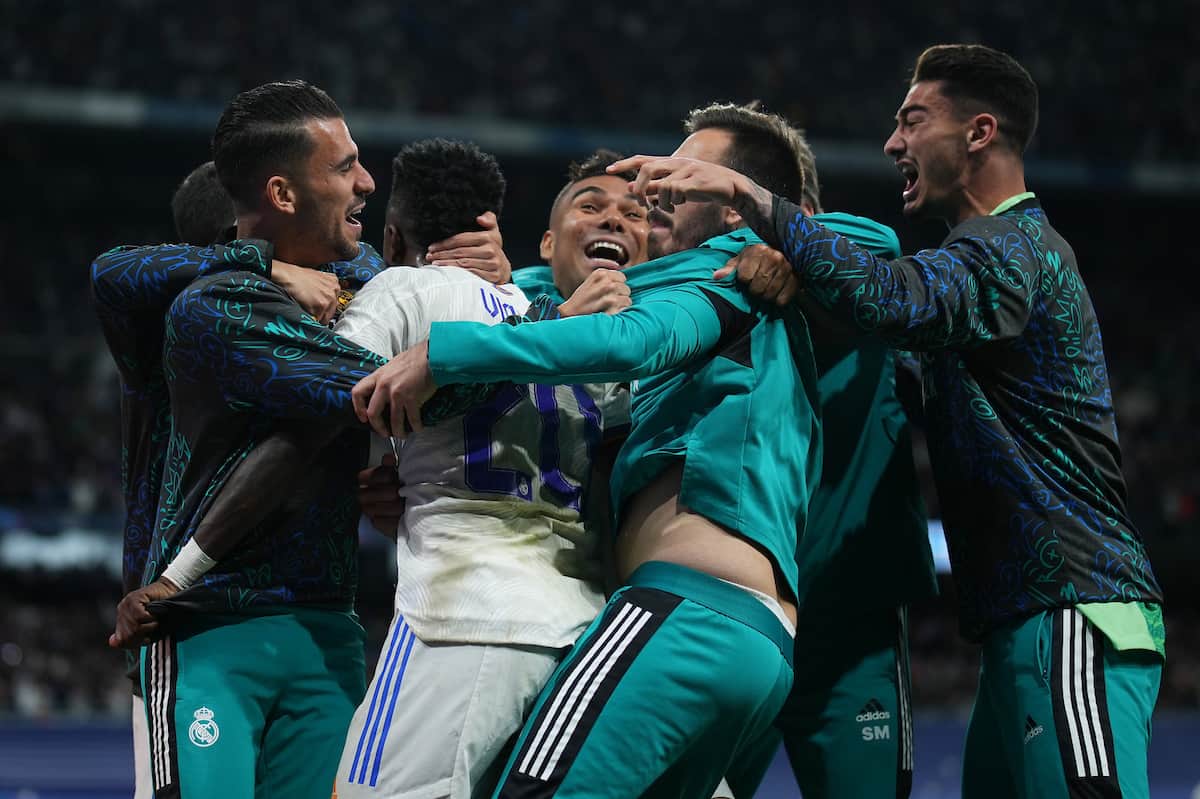
The whole team was responsible here – they failed to steal the ball in any phase of play, and they also didn’t protect the space once Madrid opened it up.
If Liverpool are to get past Madrid this time around, they must be ‘hungry to defend’ once again.
One positive example to note came in the 86th minute. With Liverpool pushing for the equaliser, inevitably space opened up for Madrid to wrap things up on the counter.
The game state forced the Reds to trust their defenders one-on-one, and they largely delivered.
Here, Benzema is able to spin Vinicius Jr. in behind.

When the ball is laid off to Benzema, Alexander-Arnold stands up to the future Ballon d’Or winner…
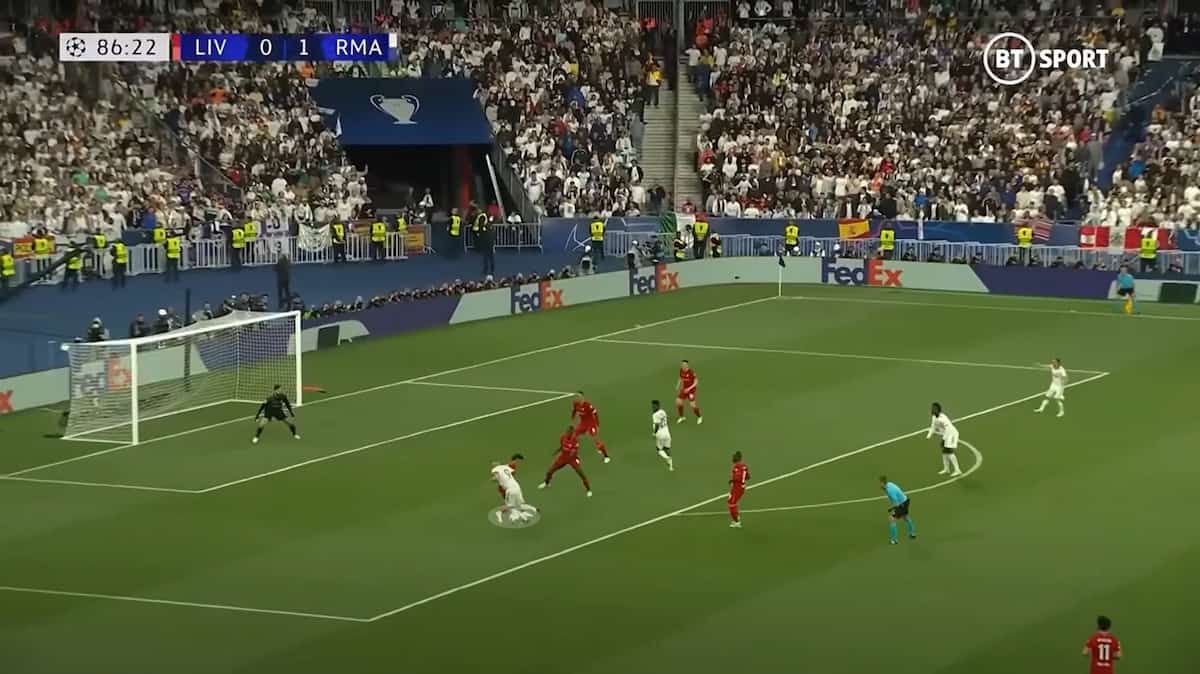
…making a brilliant tackle and immediately spraying an accurate pass forward for a Liverpool break.
“Winning a one-on-one situation is at the start of most goals,” Pepijn Lijnders explained in his recent book Intensity.
If Liverpool can rediscover this tactic, they’ll have a great chance of outdoing the Spanish champions.
Solve problems with creativity
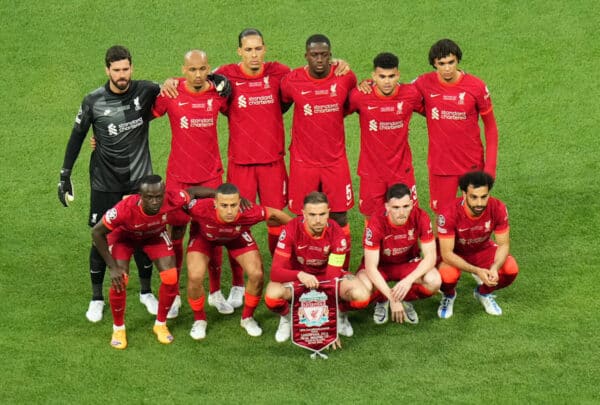
One of the reasons this fixture is so interesting is it pits a team that likes to control the ball against a team that likes to control the space.
The way Liverpool solve Madrid’s compact approach is with creative passing and movement. The first example of this came in the 17th minute.
Liverpool play a series of quick passes, constantly moving and manipulating Madrid’s defensive players until an opening appears.

When Robertson sees the gap, he plays the first pass forward – another of Liverpool’s principles of play – into Sadio Mane‘s feet.
Note how many white shirts are already filling up the box, with more rushing back in.
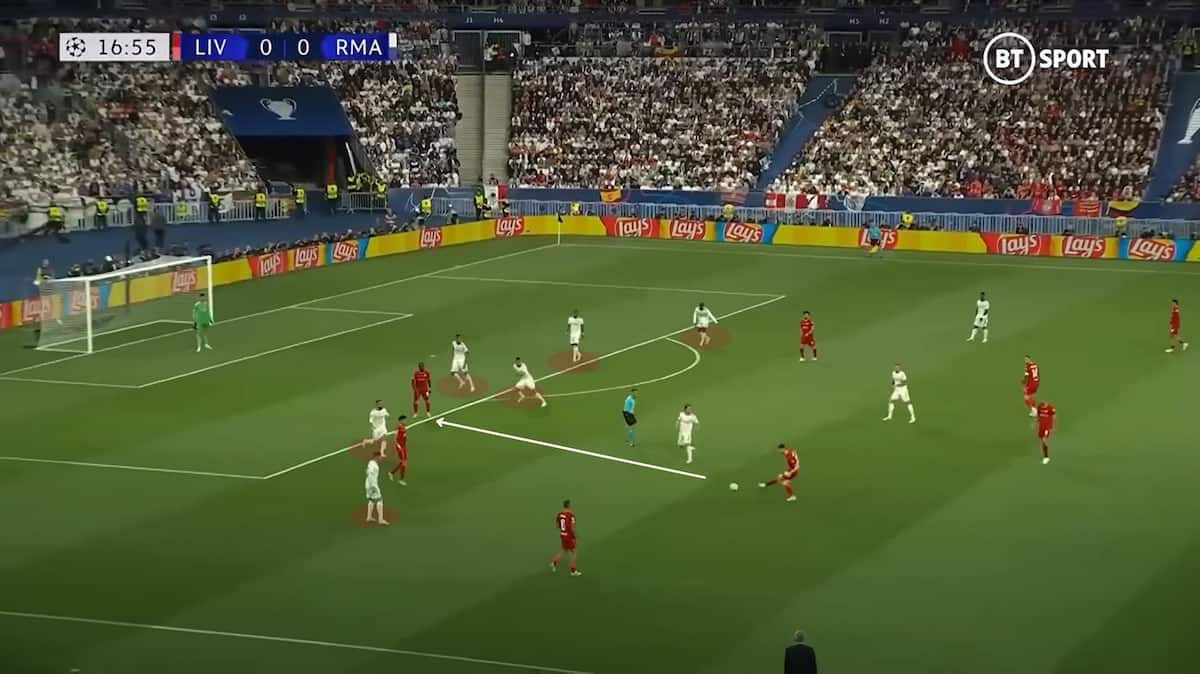
Mane cleverly slows the play down, then plays a perfectly timed disguise pass into the oncoming Salah.

The shot is slightly rushed and Courtois saves – but it’s a great example of how Liverpool can combine an aggressive team approach with individual brilliance to carve open Real’s rearguard.
We could see the likes of Naby Keita, Roberto Firmino and Harvey Elliott – players who are excellent in tight spaces – start this game with the intent to play pass-and-move.
Play the first pass forwards

Liverpool so far have been unable to take the lead against Madrid, scoring one equaliser and one deficit-reducer in the last four meetings.
There may be a familiar situation at Anfield where Liverpool need to take more risks and stretch the play in search of a goal. This is where the ‘first pass forwards’ principle takes on new meaning.
We first saw it in the 68th minute.
Alexander-Arnold wins the ball to create a second phase from a corner. With options still lingering in the box, Jordan Henderson clips a ball over the top for Salah.

The two then combine to get a cross to the back post, which Diogo Jota cleverly heads across the face of goal.

Only brilliant anticipation from Courtois prevents Salah from scoring a tap-in at the far post.
When a team seeks to sit back and protect a lead or a draw, the attacking side can be drawn into passing too conservatively, fearful of giving the ball away and losing the initiative.
At 1-0, Liverpool had to be brave to make runs and offers off the ball, and play the first forward pass they could see.
This courage led to the best chance of the game. Fabinho plays a first-time ball over the top for Salah…
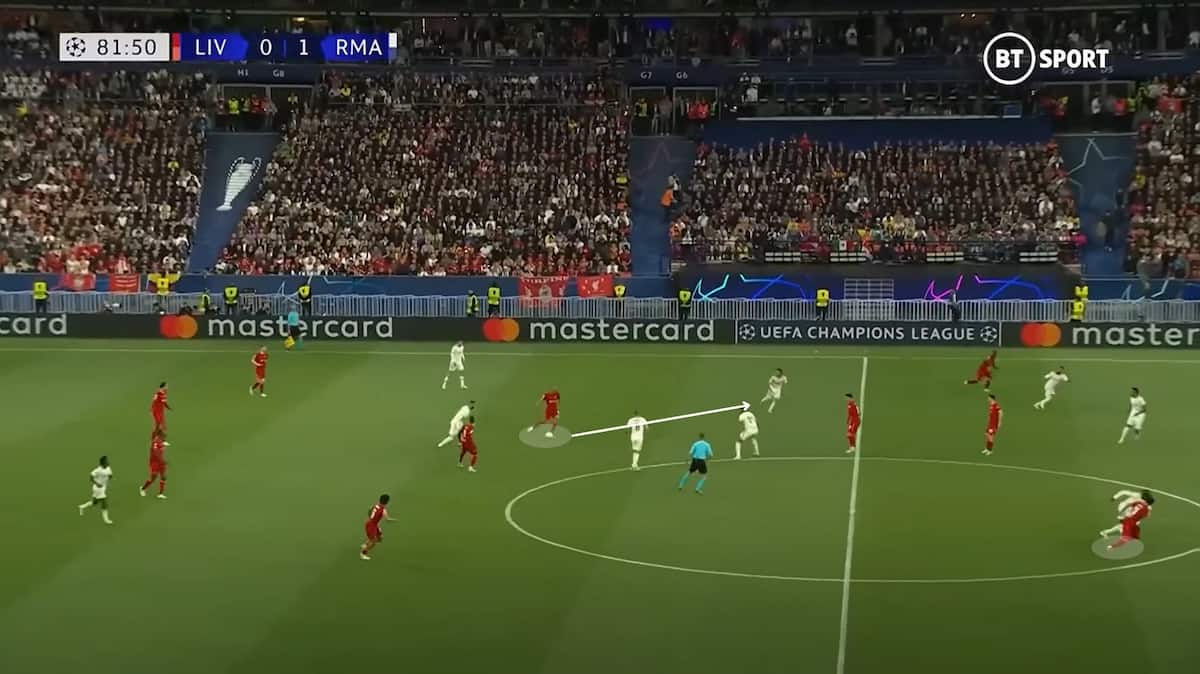
…who goes one-on-one with Ferland Mendy, skipping past him before firing towards goal.
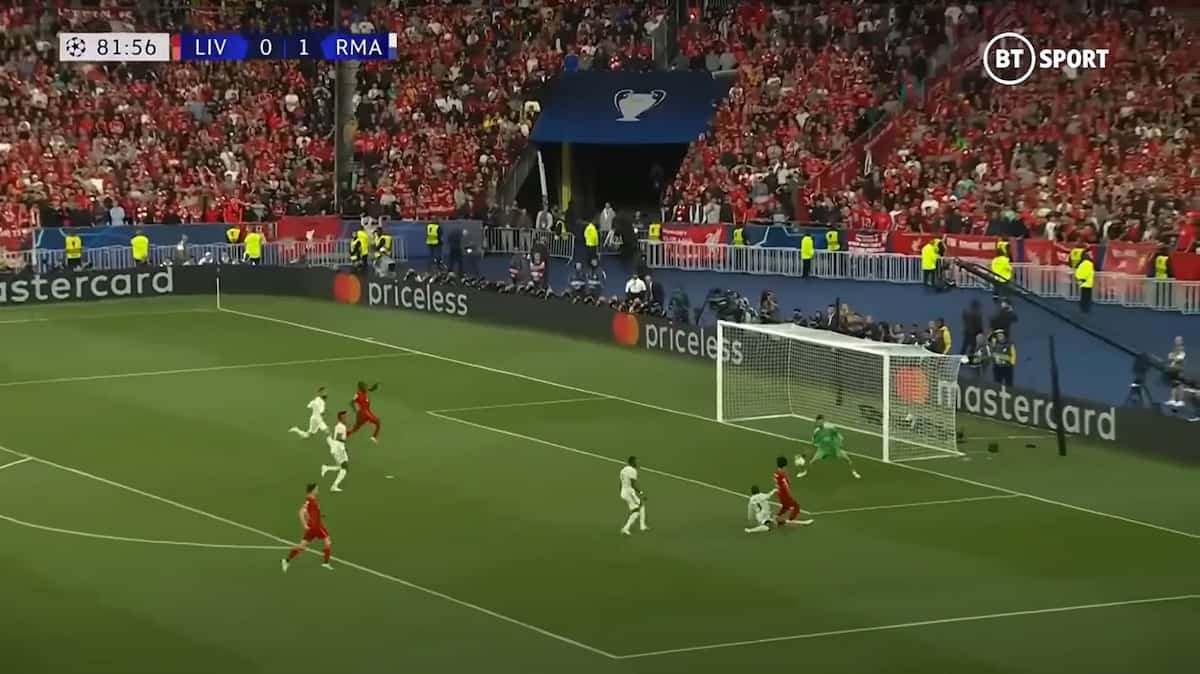
Courtois’ ninth and final save was also his best, as he tipped Salah’s effort behind.
Since Paris, Liverpool have added an exceptional transitional player in Darwin Nunez and an outstanding dribbler in Cody Gakpo.
Both players thrive in situations where they have a lot of space to operate – the antithesis of the short pass-and-move approach Liverpool started this game with.
If the first leg opens up, Liverpool have the capacity to play direct. They’ll also need the courage.
Over to Anfield
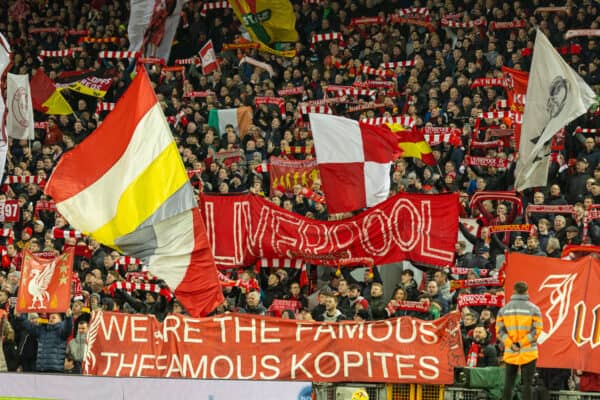
So here’s the gameplan for the first leg at Anfield: don’t press the goal kicks, defend like lions, solve problems with creativity and play the first pass forward.
And hope Thibaut Courtois has a stinker, ideally.
Can Liverpool rise to the occasion? We’ll finish with a quote taken from another Champions League tie with Spanish giants at Anfield:
“Because it’s you, we have a chance.”
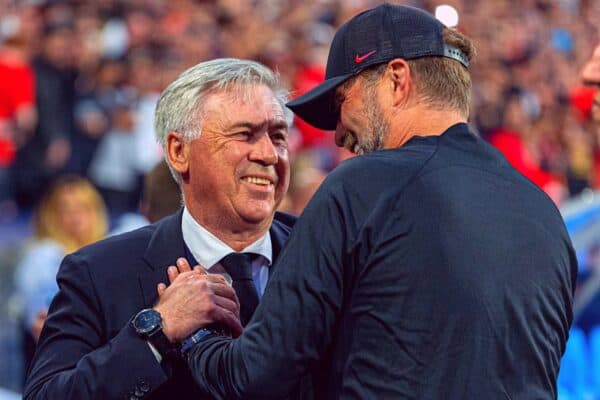





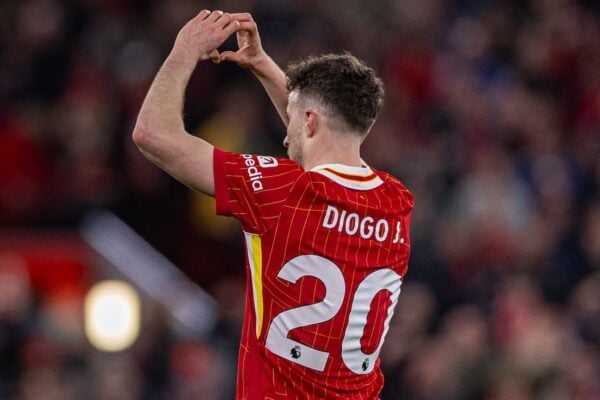










Fan Comments